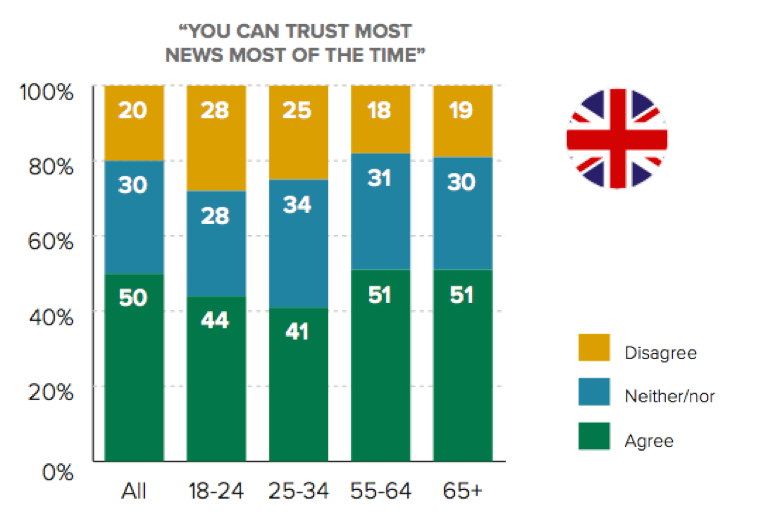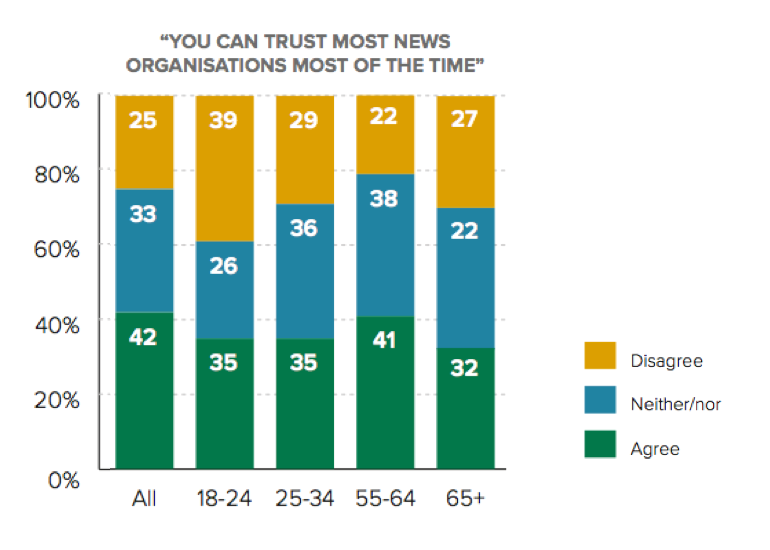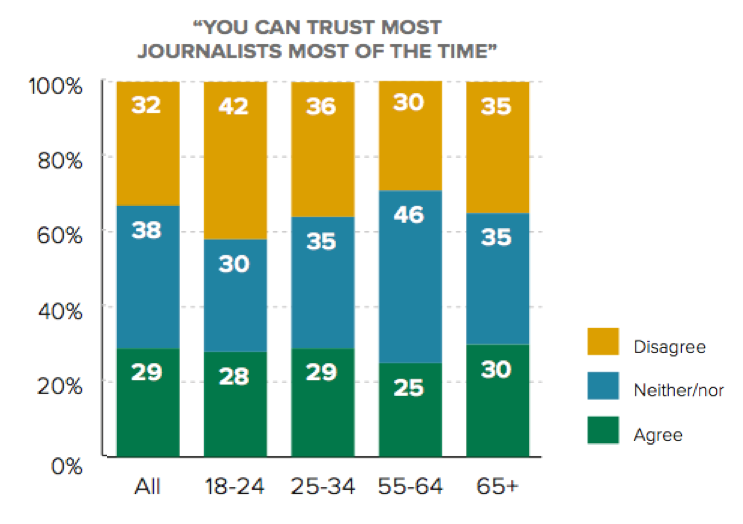This essay examines the factors that shape people’s trust in news with a focus on the UK. Given the range of platforms used for news and the variation in the numbers of sources used, the reasons people have for trusting the news are also quite diverse. Many of these reasons remain constant, such as the need for a news brand to be reliable, impartial, and accurate; to have built up a reputation over time; to be consistent.
However, other reasons that emerge in this quantitative and qualitative research have the potential to be more disruptive, such as trust being allotted to sources which are more ‘direct’ rather than mediated, and to sources which display a transparent, ‘congruent’ ethos – potentially regardless of the particular editorial stance they might take. In addition, some people are taking a more active role in deciding whether or not to trust their news sources. They are aware that there are a wide range of views and that they need to make a number of judgements about the veracity of what they are consuming. And finally, there is a need to consider the normative dimensions of trust – to what extent does a lack of trust in news signify considered due caution, or disaffected cynicism?
This essay explores these themes, focusing on the UK data in order to compare and contrast the views and habits of younger and older news users. It draws upon both the quantitative online survey and the qualitative focus groups carried out with active news users in a range of countries including the UK. 1
News Consumption Habits are Strongly Stratified by Age
As initial context, it’s useful to remind ourselves of the extent to which different age groups prefer different types of news source, as Figure 1 illustrates. When asked for their main type of news source, 9% of online news users 2 aged 18–24s nominated TV, compared to 54% of those aged 65+. Conversely, 84% of the 18–24 group nominated any online news source, compared to 15% of those aged 65+.
Figure 1: Main sources used for news (Q4)
| FIELD1 | All | 18-24 | 25-34 | 55-64 | 65+ |
|---|---|---|---|---|---|
| Any online | 42% | 84% | 62% | 27% | 15% |
| Any TV | 40% | 9% | 21% | 53% | 54% |
| Any printed | 10% | 4% | 9% | 10% | 19% |
| Radio | 8% | 2% | 7% | 9% | 10% |
Base: All/18-24s/25-34s/35-44s/45-54s/55+ who have used at least one source of news in the last week: UK = 1960/204/194/279/389/894
Social media is the preferred source for one quarter (24%) of 18–24s, compared to 1% of those aged 65+. That said, when the types of online news source are examined, ‘traditional’ broadcast and print sources online account for 55% of 18–24s’ preferred news sources, showing that younger people’s preference for online is currently as much about the means of access rather than the type of news brand being consumed.
Figure 2: Main sources used for news (Q4)
| Type | All | 18-24 | 25-34 | 55-64 | 65+ |
|---|---|---|---|---|---|
| Online TV/radio | 20% | 35% | 26% | 14% | 7% |
| Online press | 11% | 21% | 17% | 7% | 6% |
| Social media | 8% | 24% | 13% | 4% | 1% |
Base: All/18-24s/25-34s/35-44s/45-54s/55+ who have used at least one source of news in the last week: UK = 1960/204/194/279/389/894
It is clear that for younger age groups in particular, news is being accessed on new platforms. To what extent does this mean that multiple sources of news are being consumed? When online sources of news are compared, younger people are twice as likely to be using a variety of sources as older age groups – 17% of 18–24s use five or more online sources compared to 11% of 55–64s and 8% of those aged 65+. And there remains a significant minority – around one quarter – across the age groups who only use one online source for news. Attitudes about trust are likely to be coloured by the extent to which people are accessing many or few news sources. Using a variety of sources with different editorial stances can bring an awareness of the fundamental subjectivity in news provision;
this can lead to heightened scepticism about the veracity of news outlets, but can also result in increased trust and affinity for those sources that are judged to be reliable.
Accuracy and Impartiality Remain Core Attributes of Trust
The qualitative focus groups provide a reminder of the varied dimensions of trust for news users. Accuracy and impartiality remain fundamental pillars of trust for many. If news is to be trusted, it needs to provide a coherent, consistent, accurate overview of the news story, thoroughly researched and checked. As one focus group participant described in more general terms:
You’ve always got that friend that’ll just tell it as it is and then you’ve got that friend that’ll just exaggerate and elaborate … There’s the good storyteller but then there’s the person that will actually tell you what actually happened.
(20–34 Female, US Focus Group)
This requirement for accuracy is overlaid with a need to be familiar with the news brand, to know what to expect from them, which in turn is connected to a need for a news brand to have integrity, or a set of values that the user identifies with.
I find it’s the editorial style which gives it credence. If it’s well written and it’s easy to read and it isn’t glaring. Say for instance the style doesn’t change from article to article. That’s what the job of the editor is to do is kind of like coalesce all these wildly creative writers to kind of form a singular sort of consensus and thread inside of the newspaper.
(20–34 Male, UK Focus Group)
For some, the ethos of a news brand is linked to its transparency, or congruence. These factors are separate to whether or not the brand is accurate or impartial. For example, one respondent preferred BuzzFeed to the Mail Online because:
I think for me the difference between BuzzFeed and the Mail [is] they’re both not serious. Not very credible sources. Not well written but like for me BuzzFeed knows that it’s that. Whereas every time I click on the Mail I feel really guilty because I know that it’s rubbish.
(20–34 Female, US Focus Group)
This point of view implies that it is the overtness of the editorial stance that encourages trust, rather than necessarily the content of that editorial stance.
Lack of Mediation is a Core Dimension of Trusted News
In addition to these factors, both the survey and the qualitative groups indicate that another core factor in trust is the unmediated nature of some types of news. Figure 3 sets out the UK survey responses to three different attitude statements – ‘I think you can trust most news most of the time,’ ‘I think you can trust most news organisations most of the time’, and ‘I think you can trust most journalists most of the time’.
The most general statements, about news overall, commands the highest levels of agreement, with around half of respondents agreeing and one in five disagreeing. Younger age groups are less likely to agree, and 28% of 18–24s say they disagree that news in general can be trusted (see Figure 3).
Figure 3: Levels of trust in types of news



Base: Total sample/18-24s/25-34s/55-64s/65+: UK = 2024/220/206/438/467
When asked about organisations, levels of agreement are somewhat lower, with around four in ten agreeing that they can mostly be trusted, decreasing to 35% for 18–24s. And when asked about journalists, only three in ten agree they can be trusted, with more people saying they disagree that they can be trusted – including 42% of 18–24s.
In other words, more mediated forms of news provision are less likely to be trusted. The benefits of unmediated news were also highlighted in the qualitative research. As one respondent said about social media:
I totally know what you mean whenever you say trustworthy for social media because I mean … it’s one thing one person’s saying. Oh such and such has just happened in Bangladesh but then someone from Bangladesh who you can tell is there can say actually no, I’m here and this happened.
(20–34 Male, UK Focus Group)
Similarly, there are some signs that images and video are seen as more unmediated than text, and therefore more trustworthy. There has been growth since 2014 in the consumption of video for online news, from 16% in 2014 to 22% in 2016, although compared to 2015 (21%) there has been no change. In qualitative groups, respondents spoke about the value of being able to see news events unfold, or to watch a particular interviewee:
If they’re interviewing someone you can weigh them up more. You can sort of see.
(20–34 Male, UK Focus Group)
Triangulation Increasingly Necessary in Building Trust
However, unmediated news requires triangulation with other sources, as another respondent notes:
Twitter can often be just a normal person on the ground. It could be a refugee. It could be someone living near Calais in France for example. And just reporting as they see it. And quite often you do have to take this with a pinch of salt. But again I can’t really, unless it’s from someone who you know, you can’t really make an opinion out of it unless you compare it to other similar sources.
(20–34, Male, UK Focus Group)
For the active news users in the qualitative groups, this triangulation, or curation, of news input was seen as an increasingly necessary activity because of the range of available sources. This could be time-consuming and lead to uncertainty about what to trust, and there was some wistfulness in the younger age-group for the printed press:
You read what’s in front of you … If you have a newspaper you read it, you’re not drawn into you know digressing into another app to bring you to another app to another source to another, to YouTube to watch a video.
(20–34 Female, UK Focus Group)
As people become more aware of inherent subjectivity of ‘truth’ in relation to news output, they need to assess for themselves the trustworthiness of the sources that they use. For active news users, assessment across a range of sources is providing them with a complex, nuanced, but workable topography of trust. For those with a narrower range of news sources and less interest, the landscape is more limited.95 While the quotes in this essay come from the two groups held in London, wider research findings from the cross-national groups are also included.
- While the quotes in this essay come from the two groups held in London, wider research findings from the cross-national groups are also included. ↩
- The Digital News Survey is conducted online and comprises a sample of online news users. Respondents are therefore more likely to use online forms of news than respondents in face-to-face surveys. ↩
